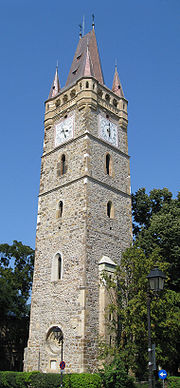.gif)
Stephen's Tower (Baia Mare)
Encyclopedia

Baia Mare
Baia Mare is a municipality in northwestern Romania and the capital of Maramureş County. The city is situated about 600 kilometres from Bucharest, the capital of Romania, 70 kilometres from the border with Hungary and 50 kilometres from the border with Ukraine...
, Romania
Romania
Romania is a country located at the crossroads of Central and Southeastern Europe, on the Lower Danube, within and outside the Carpathian arch, bordering on the Black Sea...
. Over 40 metres (131.2 ft) high and built in a neo-Gothic
Gothic Revival architecture
The Gothic Revival is an architectural movement that began in the 1740s in England...
style, it is a symbol of the city.
Eventually used for strategic observation and detecting fires, Stephen's Tower was initially a bell tower for Saint Stephen's church, built in 1347-76 as the only double-naved church in mediaeval northwest Transylvania
Transylvania
Transylvania is a historical region in the central part of Romania. Bounded on the east and south by the Carpathian mountain range, historical Transylvania extended in the west to the Apuseni Mountains; however, the term sometimes encompasses not only Transylvania proper, but also the historical...
. The church (50.6 m long and 19 m wide, with naves 25 m long), though not quite finished, was dedicated in 1387, when it was first mentioned as St. Stephen's. The bell tower was added in 1446 on the church's southwest side; it was begun during John Hunyadi
John Hunyadi
John Hunyadi John Hunyadi (Hungarian: Hunyadi János , Medieval Latin: Ioannes Corvinus or Ioannes de Hunyad, Romanian: Iancu (Ioan) de Hunedoara, Croatian: Janko Hunjadi, Serbian: Сибињанин Јанко / Sibinjanin Janko, Slovak: Ján Huňady) John Hunyadi (Hungarian: Hunyadi János , Medieval Latin: ...
's reign in honour of his 1442 victory over the Ottomans
Ottoman Empire
The Ottoman EmpireIt was usually referred to as the "Ottoman Empire", the "Turkish Empire", the "Ottoman Caliphate" or more commonly "Turkey" by its contemporaries...
near the Ialomiţa River
Ialomita River
The Ialomiţa is a river of Southern Romania that rises from the Bucegi Mountains in the Carpathians and flows into the Danube.The upper reach of the river is sometimes known as Valea Obârşiei or Obârşia Ialomiţei.-Localities:...
and completed in 1468 under his son Matthias Corvinus
Matthias Corvinus of Hungary
Matthias Corvinus , also called the Just in folk tales, was King of Hungary and Croatia from 1458, at the age of 14 until his death...
.
In the mid-16th century the tower and church were partly destroyed by powerful lightning. The tower was rebuilt in 1559-61; the church passed from Roman Catholic
Roman Catholic Church
The Catholic Church, also known as the Roman Catholic Church, is the world's largest Christian church, with over a billion members. Led by the Pope, it defines its mission as spreading the gospel of Jesus Christ, administering the sacraments and exercising charity...
to Reformed
Reformed Church in Romania
The Reformed Church in Romania is the organization of the Calvinist church in Romania. The majority of its followers are of Hungarian ethnicity and Hungarian is the main church language...
control in 1588. In 1619 both structures underwent a thorough restoration: the tower received a new roof, high and sharp-pointed, in the shape of a square-based pyramid. In 1628 four mechanical clocks with moons (one on each face), manufactured by a Prešov
Prešov
Prešov Historically, the city has been known in German as Eperies , Eperjes in Hungarian, Fragopolis in Latin, Preszów in Polish, Peryeshis in Romany, Пряшев in Russian and Пряшів in Rusyn and Ukrainian.-Characteristics:The city is a showcase of Baroque, Rococo and Gothic...
clockmaker, replaced the tower's bell. Another lightning-induced fire in 1647 devastated the church and tower. Yet another fire seriously damaged both structures when they were again hit by lightning in 1769. The tower was rebuilt the following year, when the gallery was raised a level and the roof redone in Baroque
Baroque architecture
Baroque architecture is a term used to describe the building style of the Baroque era, begun in late sixteenth century Italy, that took the Roman vocabulary of Renaissance architecture and used it in a new rhetorical and theatrical fashion, often to express the triumph of the Catholic Church and...
onion-dome style. The church was in ruins and repairs estimated to be very costly, so the authorities decided to demolish its remaining walls in 1847 using gunpowder; the former church site became a park in 1856, with Ferenc Schulz's 1870 plan for rebuilding it remaining unimplemented, and only the bell tower remained standing. This was destroyed by fire in 1869 and rebuilt in 1898-99 in neo-Gothic style, a form it preserves to this day.
The aged light green slate roof was damaged by a storm in 2007; repairs, finished the following year at a cost to the city of some €200,000, included its replacement with a copper roof. The tower is open to visitors.

